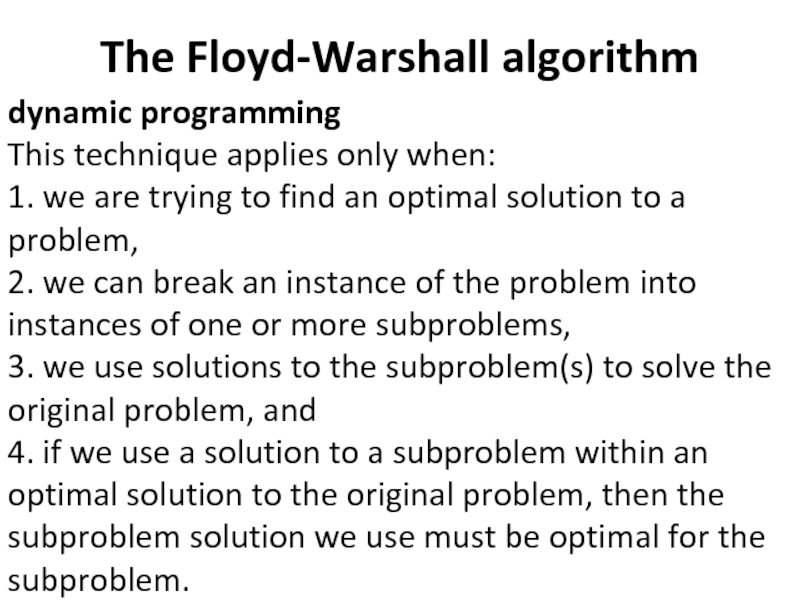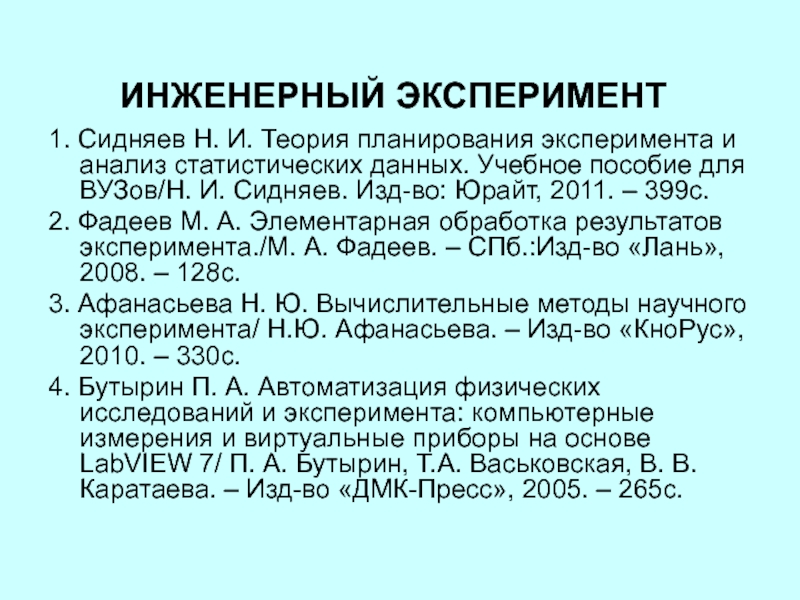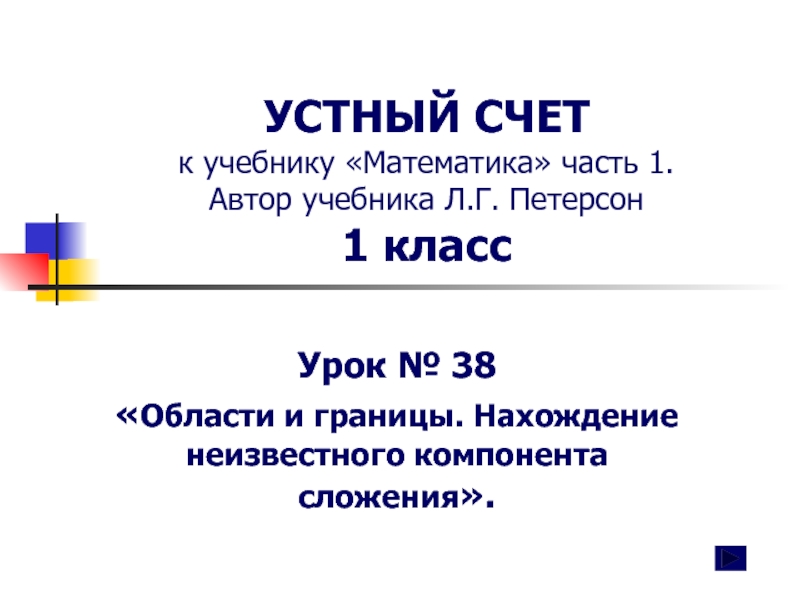- Главная
- Разное
- Дизайн
- Бизнес и предпринимательство
- Аналитика
- Образование
- Развлечения
- Красота и здоровье
- Финансы
- Государство
- Путешествия
- Спорт
- Недвижимость
- Армия
- Графика
- Культурология
- Еда и кулинария
- Лингвистика
- Английский язык
- Астрономия
- Алгебра
- Биология
- География
- Детские презентации
- Информатика
- История
- Литература
- Маркетинг
- Математика
- Медицина
- Менеджмент
- Музыка
- МХК
- Немецкий язык
- ОБЖ
- Обществознание
- Окружающий мир
- Педагогика
- Русский язык
- Технология
- Физика
- Философия
- Химия
- Шаблоны, картинки для презентаций
- Экология
- Экономика
- Юриспруденция
Shortest Paths презентация
Содержание
- 1. Shortest Paths
- 2. The Bellman-Ford algorithm 1958 1962
- 3. The Bellman-Ford algorithm
- 4. The Bellman-Ford algorithm the fixed order: (t;
- 5. The Bellman-Ford algorithm Parts (b) through (e) show the situation after each successive pass.
- 6. The Bellman-Ford algorithm The shortest and pred values in part (e) are the final values.
- 7. The Bellman-Ford algorithm Consider a shortest path
- 8. The Bellman-Ford algorithm Every acyclic path must
- 9. The Bellman-Ford algorithm The graph contains a
- 10. The Bellman-Ford algorithm How to find a
- 12. The Bellman-Ford algorithm The loop of step
- 13. The Bellman-Ford algorithm To find whether a
- 14. The Bellman-Ford algorithm Negative-weight cycles relate to arbitrage opportunities in currency trading.
- 15. The Bellman-Ford algorithm n currencies c1; c2;
- 16. The Bellman-Ford algorithm
- 17. The Bellman-Ford algorithm
- 18. The Bellman-Ford algorithm To find an arbitrage
- 19. The Bellman-Ford algorithm Add a new vertex
- 20. The Floyd-Warshall algorithm The classic example
- 21. The Floyd-Warshall algorithm There is one
- 22. The Floyd-Warshall algorithm What would be
- 23. The Floyd-Warshall algorithm Using the Floyd-Warshall
- 24. The Floyd-Warshall algorithm The Floyd-Warshall algorithm
- 25. The Floyd-Warshall algorithm the vertices are
- 26. The Floyd-Warshall algorithm Let’s consider two
- 27. The Floyd-Warshall algorithm There are two
- 28. The Floyd-Warshall algorithm adjacency-matrix representation
- 29. The Floyd-Warshall algorithm computes shortest[u; v;
- 31. The Floyd-Warshall algorithm example shortest[2; 4;
- 32. The Floyd-Warshall algorithm pred[u; v; 0] values
- 33. The Floyd-Warshall algorithm After running the loop for x=1
- 34. The Floyd-Warshall algorithm After running the
- 35. The Floyd-Warshall algorithm shortest[u; v; 4] and pred[u; v; 4] values
- 36. The Floyd-Warshall algorithm dynamic programming This
Слайд 4The Bellman-Ford algorithm
the fixed order: (t; x); (t; y); (t; z);
(x; t); (y; x); (y; z); (z; x); (z; s); (s; t); (s; y)
Part (a) shows the situation just before the first pass.
Part (a) shows the situation just before the first pass.
Слайд 5The Bellman-Ford algorithm
Parts (b) through (e) show the situation after each
successive pass.
Слайд 7The Bellman-Ford algorithm
Consider a shortest path from the source s to
any vertex v.
If we relax the edges, in order, along a shortest path from s to v, then shortest [v] and pred[v] are correct.
If there are not negative-weight cycles on the graph, then there is always a shortest path from s to v that does not contain a cycle.
If we relax the edges, in order, along a shortest path from s to v, then shortest [v] and pred[v] are correct.
If there are not negative-weight cycles on the graph, then there is always a shortest path from s to v that does not contain a cycle.
Слайд 8The Bellman-Ford algorithm
Every acyclic path must contain at most n -
1 edges. If a path contains n edges then it must visit some vertex twice, which would make a cycle.
The first time that step 2A relaxes all edges, it must relax the first edge on this shortest path. The second time that step 2A relaxes all edges, it must relax the second edge on the shortest path, and so on. After the (n – 1) time, all edges on the shortest path have been relaxed, in order, and therefore shortest [v] and pred [v] are correct.
The first time that step 2A relaxes all edges, it must relax the first edge on this shortest path. The second time that step 2A relaxes all edges, it must relax the second edge on the shortest path, and so on. After the (n – 1) time, all edges on the shortest path have been relaxed, in order, and therefore shortest [v] and pred [v] are correct.
Слайд 9The Bellman-Ford algorithm
The graph contains a negative-weight cycle and we have
already run the BELLMAN-FORD procedure on it.
=>around and around a negative-weight cycle =>getting a lower-weight path each time around
That means that there is at least one edge (u; v) on the cycle for which shortest[v] will decrease if you relax it again.
=>around and around a negative-weight cycle =>getting a lower-weight path each time around
That means that there is at least one edge (u; v) on the cycle for which shortest[v] will decrease if you relax it again.
Слайд 10The Bellman-Ford algorithm
How to find a negative-weight cycle, if one exists,
after running BELLMAN-FORD?
Go through the edges once again.
If we find an edge (u; v) for which
shortest [u]+weight(u; v) < shortest[v], then
vertex v is either on a negative-weight cycle or
is reachable from one.
Go through the edges once again.
If we find an edge (u; v) for which
shortest [u]+weight(u; v) < shortest[v], then
vertex v is either on a negative-weight cycle or
is reachable from one.
Слайд 12The Bellman-Ford algorithm
The loop of step 2 iterates n - 1
times.
The loop of step 2A iterates m times, once per edge. ? The total running time is Θ(nm).
The loop of step 2A iterates m times, once per edge. ? The total running time is Θ(nm).
Слайд 13The Bellman-Ford algorithm
To find whether a negative-weight cycle exists taking O(m)
time.
If there is a negative-weight cycle, it can contain at most n edges, and so the time to trace it out is O(n).
If there is a negative-weight cycle, it can contain at most n edges, and so the time to trace it out is O(n).
Слайд 14The Bellman-Ford algorithm
Negative-weight cycles relate to arbitrage opportunities in currency trading.
Слайд 15The Bellman-Ford algorithm
n currencies c1; c2; c3; … ; cn,
all
the exchange rates between pairs of currencies
with 1 unit of currency ci we can buy rij units of currency cj.
rij is the exchange rate between currencies ci and cj.
both i and j range from 1 to n
!!!rii = 1 for each currency ci
with 1 unit of currency ci we can buy rij units of currency cj.
rij is the exchange rate between currencies ci and cj.
both i and j range from 1 to n
!!!rii = 1 for each currency ci
Слайд 18The Bellman-Ford algorithm
To find an arbitrage opportunity, if one exists,
construct
a directed graph with one vertex vi for each currency ci.
For each pair of currencies ci and cj, create directed edges (vi; vj) and (vj; vi) with
weights -lg rij and -lg rji, respectively.
For each pair of currencies ci and cj, create directed edges (vi; vj) and (vj; vi) with
weights -lg rij and -lg rji, respectively.
Слайд 19The Bellman-Ford algorithm
Add a new vertex s with a 0-weight edge
(s; vi) to each of the vertices v1 through vn.
Run the Bellman-Ford algorithm on this graph with s as the source vertex, and
use the result to determine whether it contains a negative-weight cycle.
If it does, then the vertices on that cycle correspond to the currencies in an arbitrage opportunity.
Run the Bellman-Ford algorithm on this graph with s as the source vertex, and
use the result to determine whether it contains a negative-weight cycle.
If it does, then the vertices on that cycle correspond to the currencies in an arbitrage opportunity.
Слайд 20The Floyd-Warshall algorithm
The classic example of all-pairs shortest paths is
the table of a road atlas giving distances between several cities.
You find the row for one city, you find the column for the other city, and the distance between them lies at the intersection of the row and column.
You find the row for one city, you find the column for the other city, and the distance between them lies at the intersection of the row and column.
Слайд 21The Floyd-Warshall algorithm
There is one problem with this example: it’s
not all-pairs.
If it were all pairs, the table would have one row and one column for every intersection, not for just every city.
The number of rows and columns for just the one country would be in the millions.
If it were all pairs, the table would have one row and one column for every intersection, not for just every city.
The number of rows and columns for just the one country would be in the millions.
Слайд 22The Floyd-Warshall algorithm
What would be a rightful application of all-pairs
shortest paths?
Finding the diameter of a network: the longest of all shortest paths.
For example, suppose that a directed graph represents a communication network, and the weight of an edge gives the time it takes for a message to traverse a communication link.
Then the diameter gives you the longest possible transit time for a message in the network.
Finding the diameter of a network: the longest of all shortest paths.
For example, suppose that a directed graph represents a communication network, and the weight of an edge gives the time it takes for a message to traverse a communication link.
Then the diameter gives you the longest possible transit time for a message in the network.
Слайд 23The Floyd-Warshall algorithm
Using the Floyd-Warshall algorithm, we can solve the
all-pairs problem in Θ(n3) time.
For the Floyd-Warshall algorithm the graph can have negative-weight edges but no negative-weight cycles.
The Floyd-Warshall algorithm illustrates a clever algorithmic technique called “dynamic programming”.
For the Floyd-Warshall algorithm the graph can have negative-weight edges but no negative-weight cycles.
The Floyd-Warshall algorithm illustrates a clever algorithmic technique called “dynamic programming”.
Слайд 24The Floyd-Warshall algorithm
The Floyd-Warshall algorithm relies on one property of
shortest paths.
If a shortest path, call it p, from vertex u to vertex v goes from vertex u to vertex x to vertex y to vertex v, then the portion of p that is between x and y is itself a shortest path from x to y.
That is, any subpath of a shortest path is itself a shortest path.
If a shortest path, call it p, from vertex u to vertex v goes from vertex u to vertex x to vertex y to vertex v, then the portion of p that is between x and y is itself a shortest path from x to y.
That is, any subpath of a shortest path is itself a shortest path.
Слайд 25The Floyd-Warshall algorithm
the vertices are numbered from 1 to n
Vertex
numbers become important.
shortest[u; v; x] is the weight of a shortest path from vertex u to vertex v in which each intermediate vertex – a vertex on the path other than u and v – is numbered from 1 to x
(u, v, and x as integers in the range 1 to n that represent vertices)
shortest[u; v; x] is the weight of a shortest path from vertex u to vertex v in which each intermediate vertex – a vertex on the path other than u and v – is numbered from 1 to x
(u, v, and x as integers in the range 1 to n that represent vertices)
Слайд 26The Floyd-Warshall algorithm
Let’s consider two vertices u and v.
Pick
a number x in the range from 1 to n.
Consider all paths from u to v in which all intermediate vertices are numbered at most x.
Of all these paths, let path p be one with minimum weight.
Path p either contains vertex x or it does not.
Consider all paths from u to v in which all intermediate vertices are numbered at most x.
Of all these paths, let path p be one with minimum weight.
Path p either contains vertex x or it does not.
Слайд 27The Floyd-Warshall algorithm
There are two possibilities:
First possibility: x is not
an intermediate vertex in path p. Then all intermediate vertices of path p are numbered at most x - 1. What does this mean? Shortest[u; v; x] equals shortest[u; v; x – 1].
Second possibility: x appears as an intermediate vertex in path p. Then
shortest[u; v; x] equals shortest[u; x; x – 1] +
+ shortest[x; v; x – 1].
Second possibility: x appears as an intermediate vertex in path p. Then
shortest[u; v; x] equals shortest[u; x; x – 1] +
+ shortest[x; v; x – 1].
Слайд 28The Floyd-Warshall algorithm
adjacency-matrix representation
The entry for edge (u; v) holds
the weight of the edge, with a weight of ∞ indicating that the edge is absent.
Shortest[u; v; 0] denotes the weight of a shortest path from u to v with all intermediate vertices numbered at most 0, such a path has no intermediate vertices.
Shortest[u; v; 0] denotes the weight of a shortest path from u to v with all intermediate vertices numbered at most 0, such a path has no intermediate vertices.
Слайд 29The Floyd-Warshall algorithm
computes shortest[u; v; x] values => x=1
computes shortest[u;
v; x] values => x=2
computes shortest[u; v; x] values => x=2
…
computes shortest[u; v; x] values => x=n
pred[u; v; x] as the predecessor of vertex v on a shortest path from vertex u in which all intermediate vertices are numbered at most x
computes shortest[u; v; x] values => x=2
…
computes shortest[u; v; x] values => x=n
pred[u; v; x] as the predecessor of vertex v on a shortest path from vertex u in which all intermediate vertices are numbered at most x
Слайд 31The Floyd-Warshall algorithm
example
shortest[2; 4; 0] is 1, because we can
get from vertex 2 to vertex 4 directly, with no intermediate vertices, by taking edge (2; 4) with weight 1
Слайд 36The Floyd-Warshall algorithm
dynamic programming
This technique applies only when:
1. we are
trying to find an optimal solution to a problem,
2. we can break an instance of the problem into instances of one or more subproblems,
3. we use solutions to the subproblem(s) to solve the original problem, and
4. if we use a solution to a subproblem within an optimal solution to the original problem, then the subproblem solution we use must be optimal for the subproblem.
2. we can break an instance of the problem into instances of one or more subproblems,
3. we use solutions to the subproblem(s) to solve the original problem, and
4. if we use a solution to a subproblem within an optimal solution to the original problem, then the subproblem solution we use must be optimal for the subproblem.
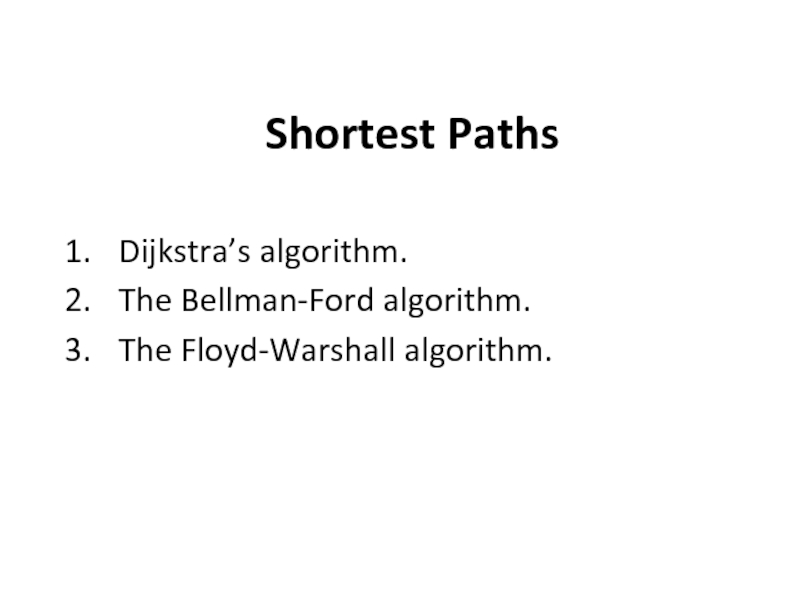

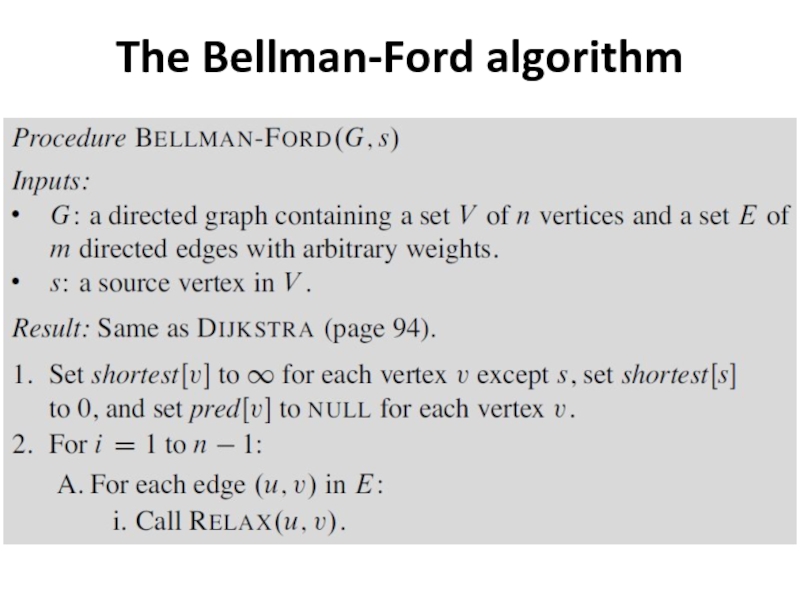
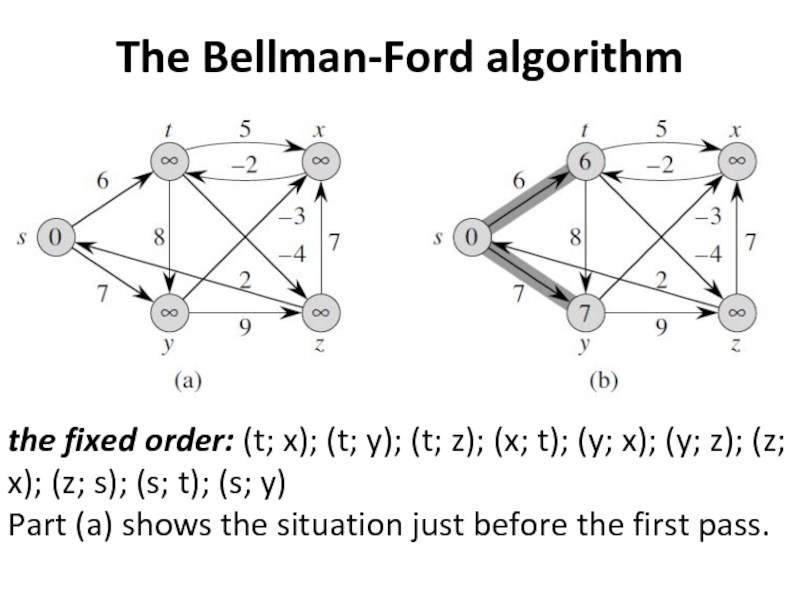
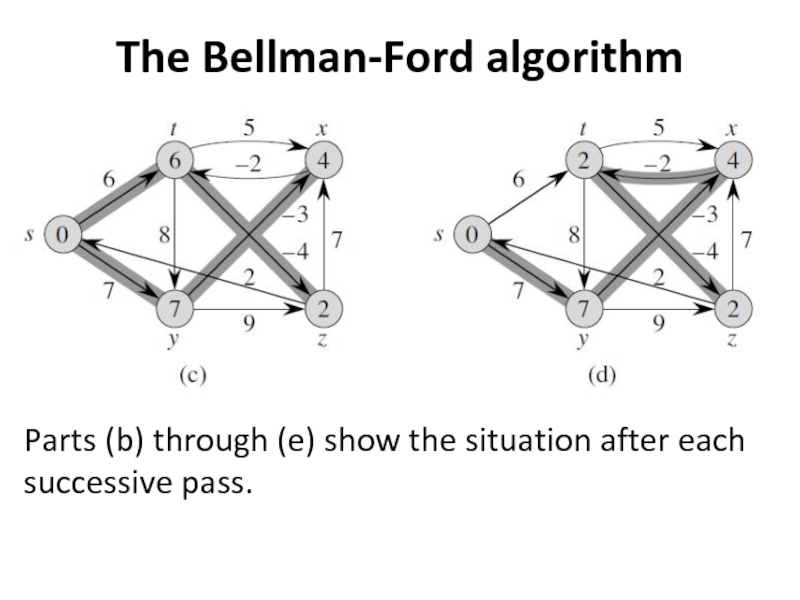
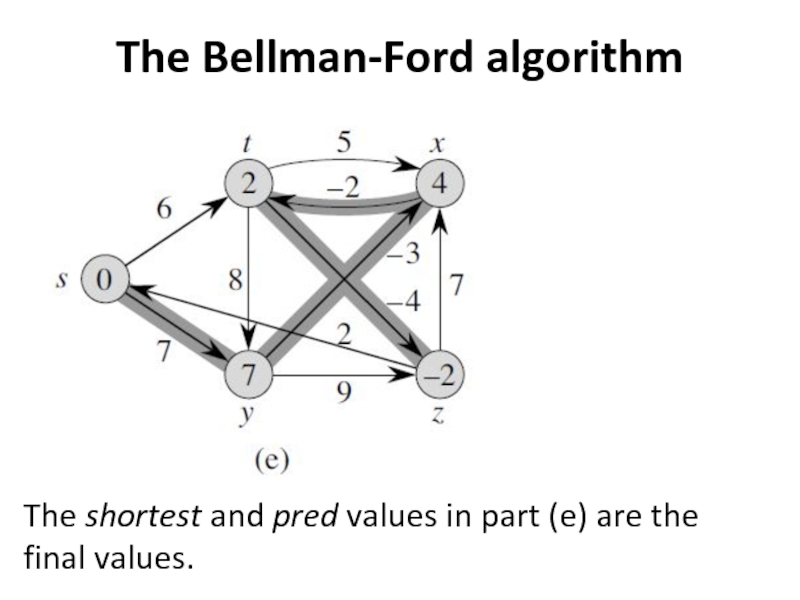
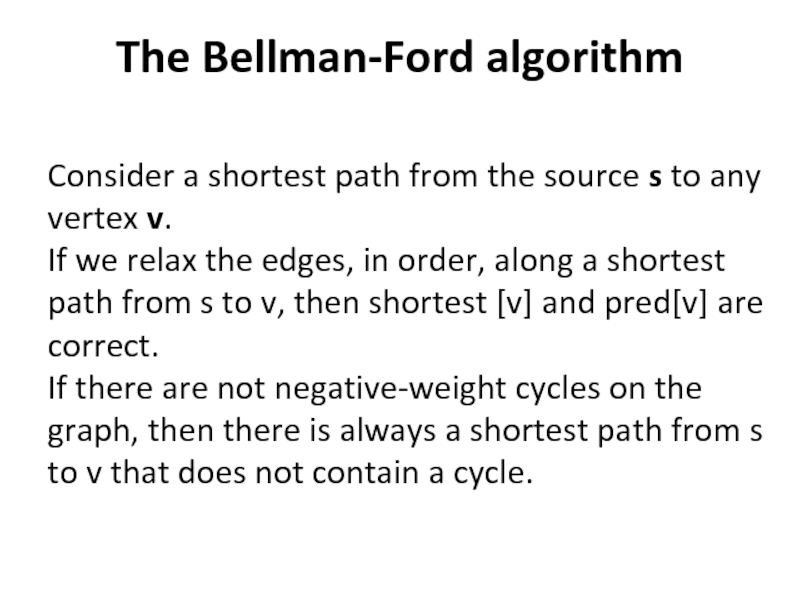
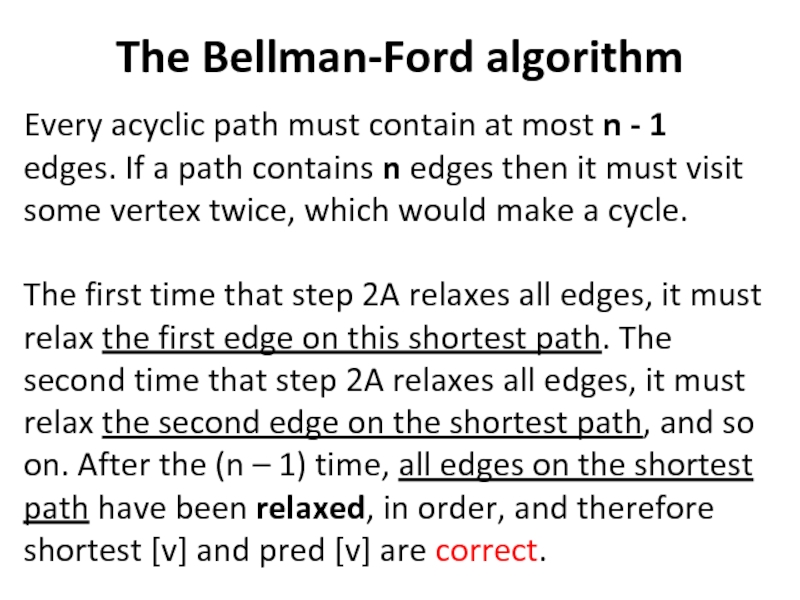
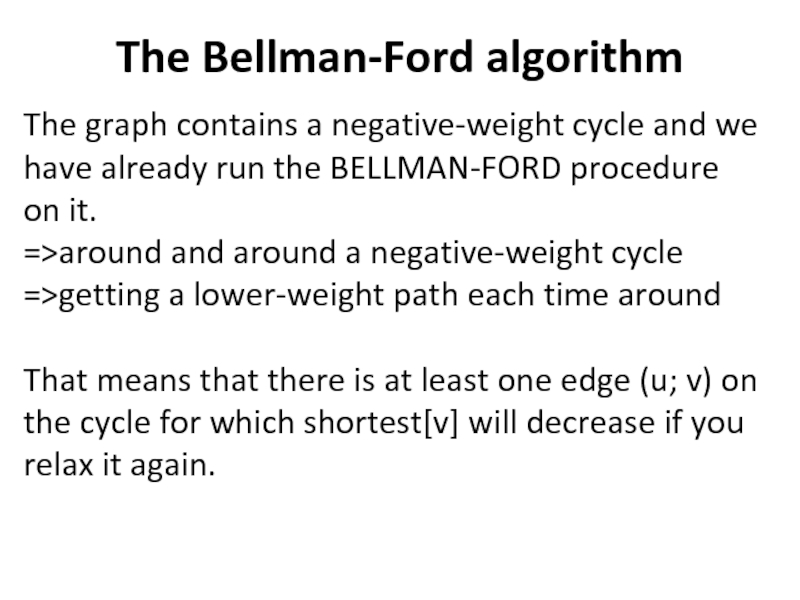
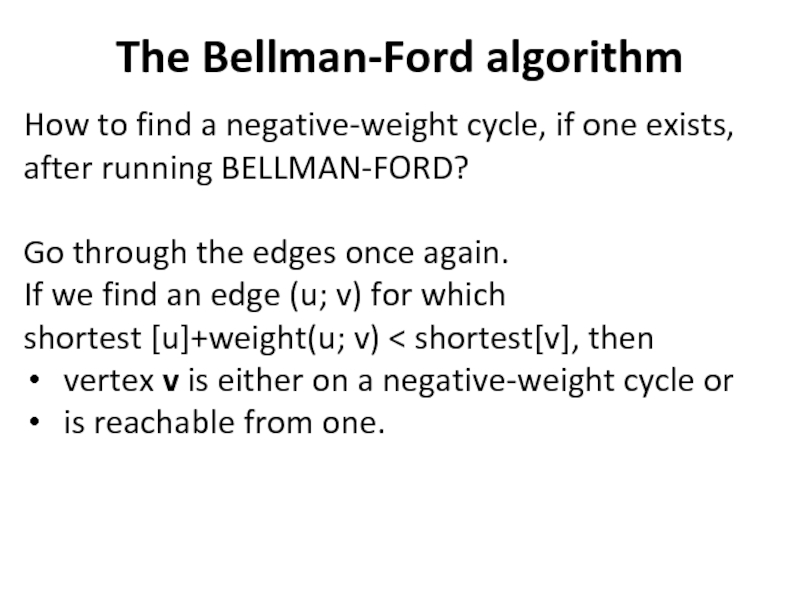
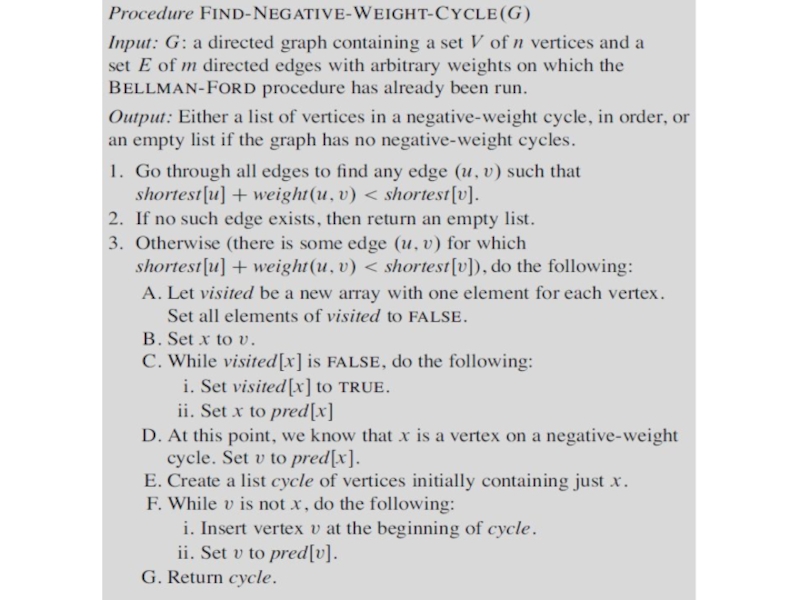
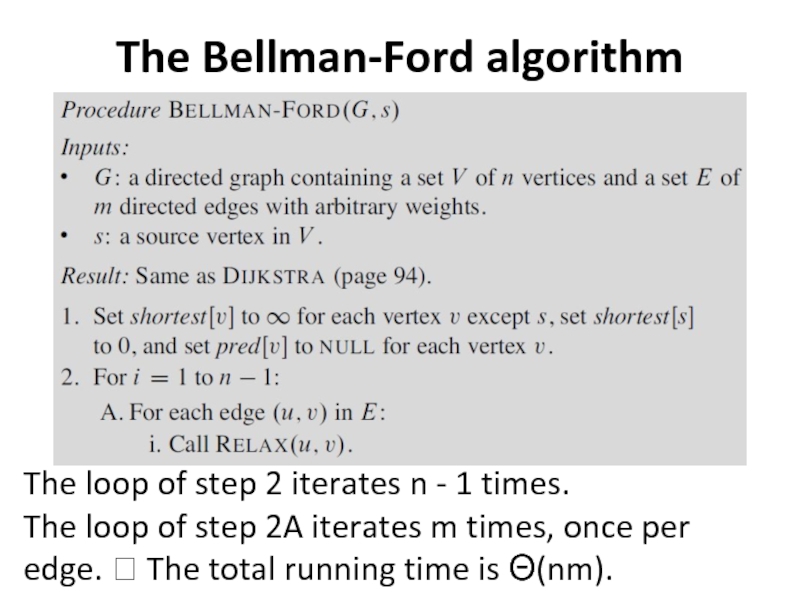
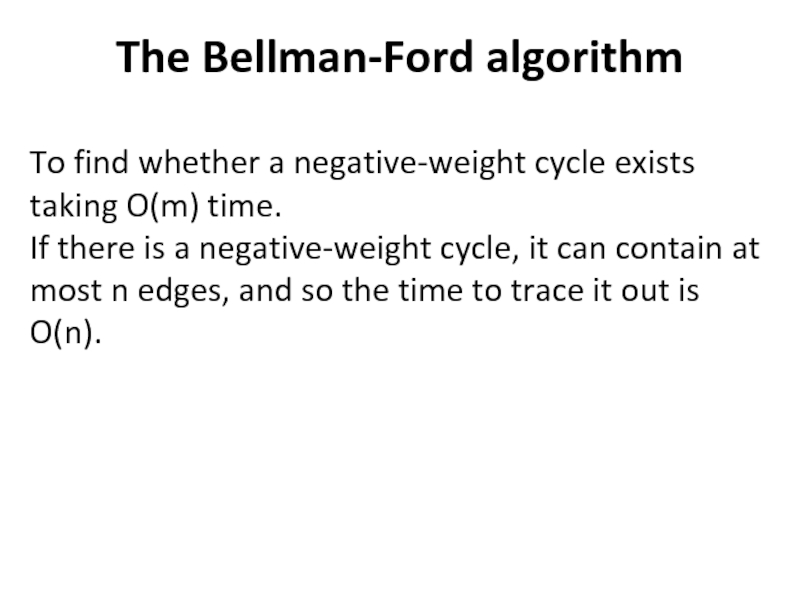

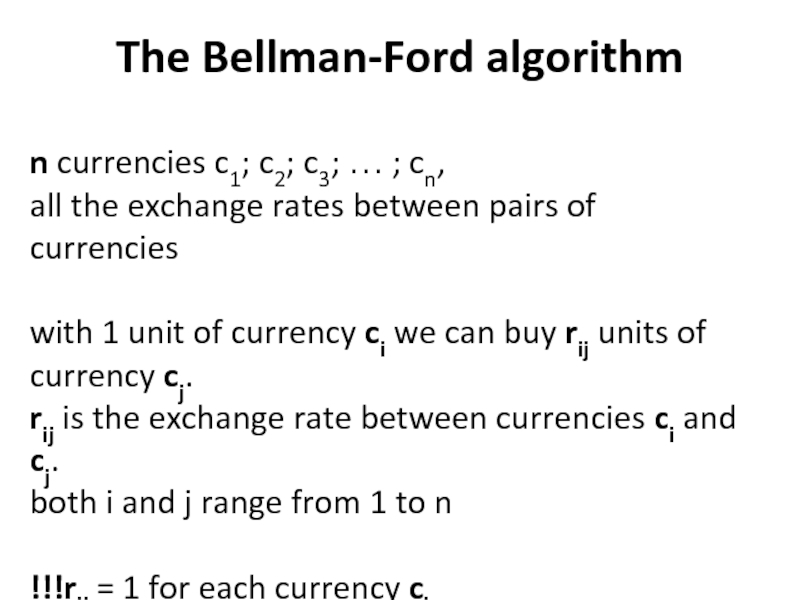
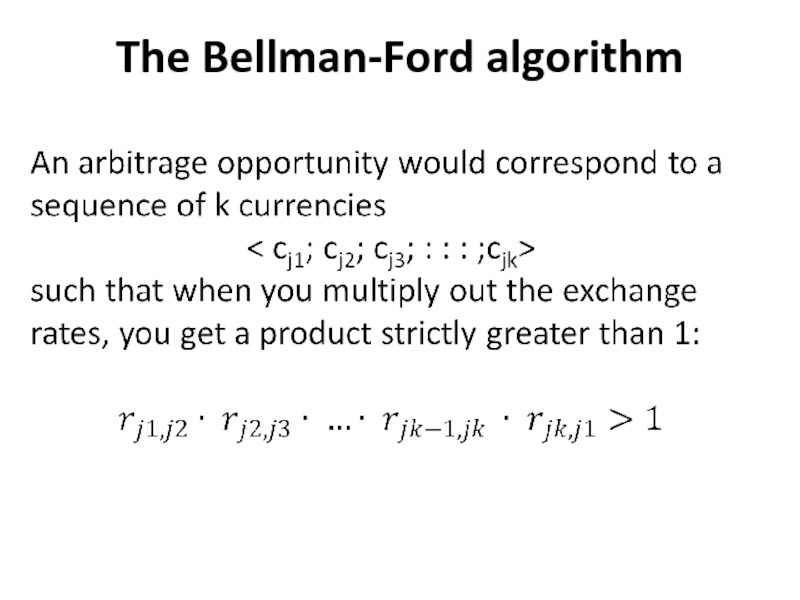
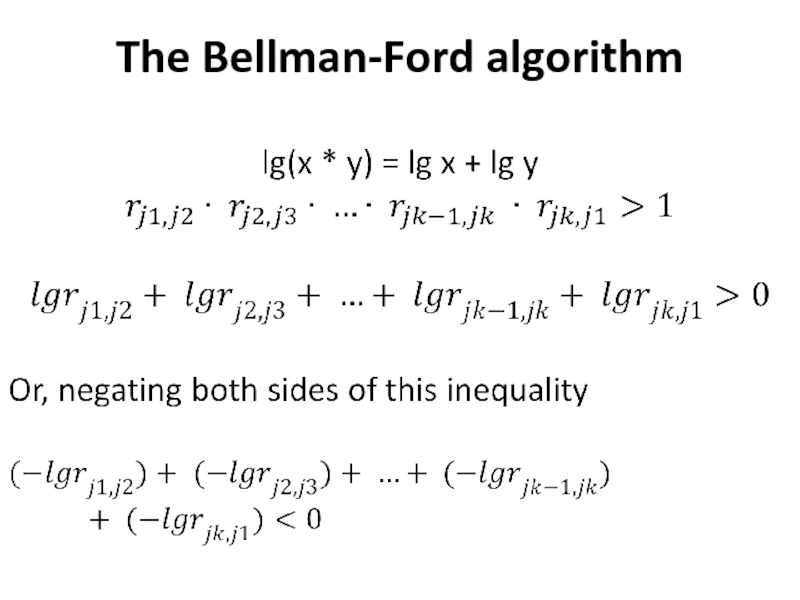
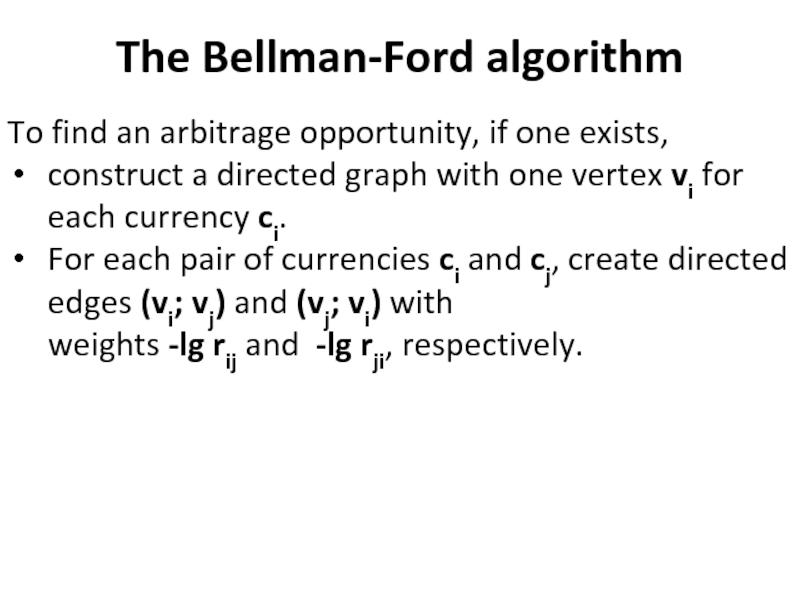
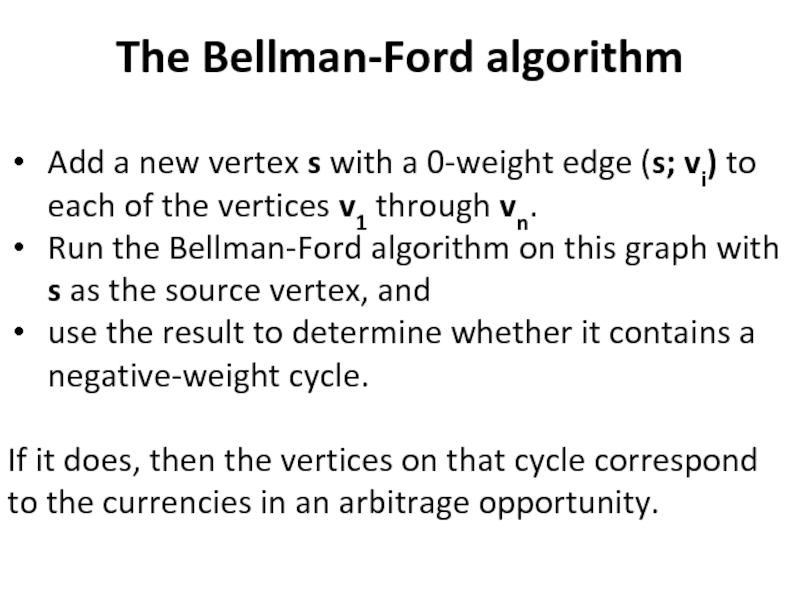
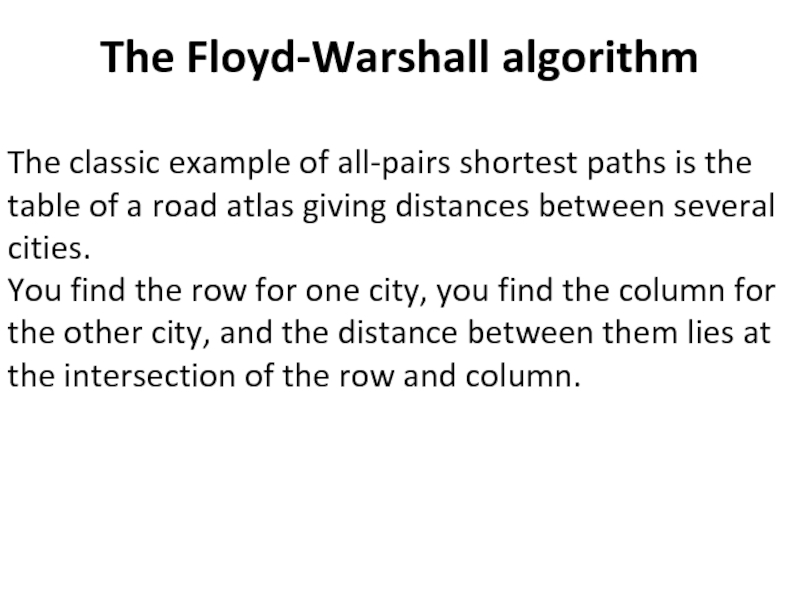

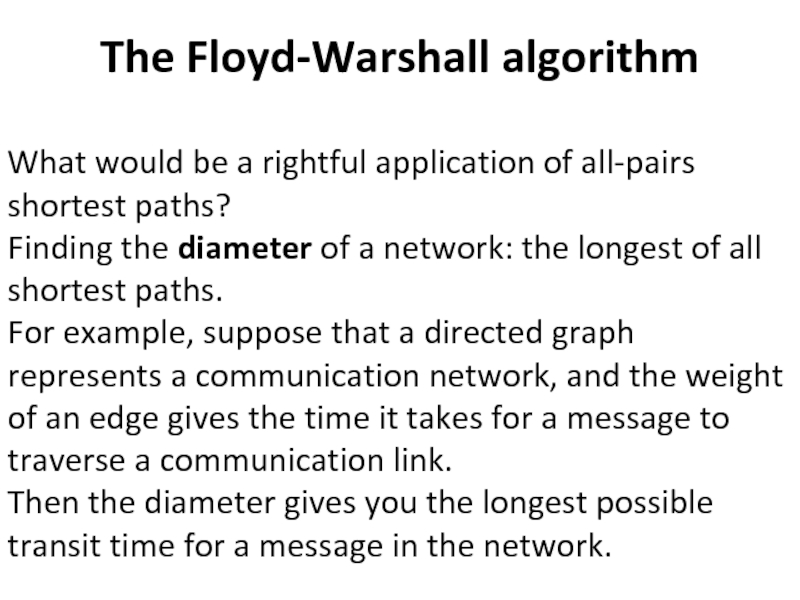
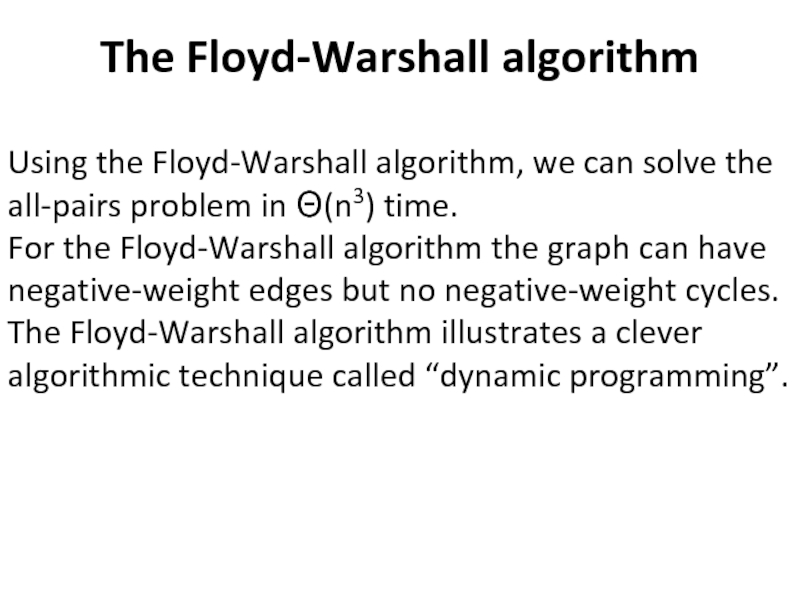
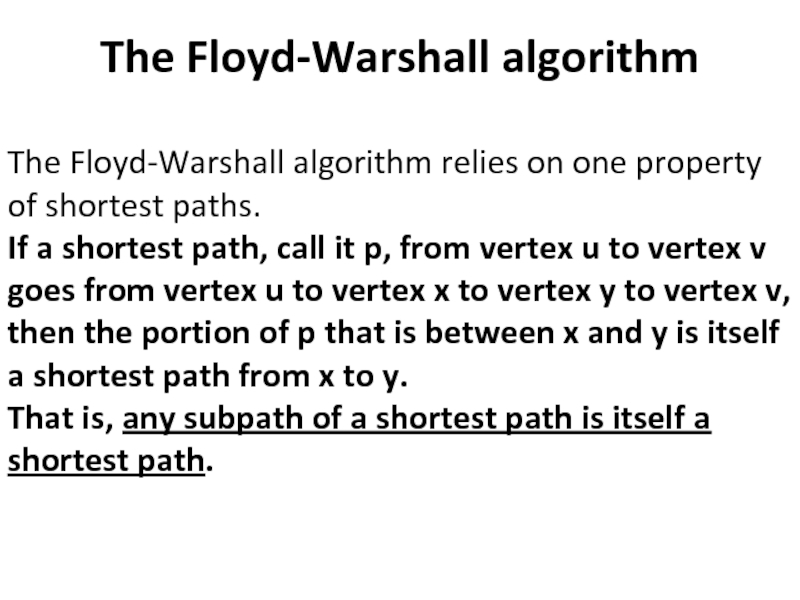
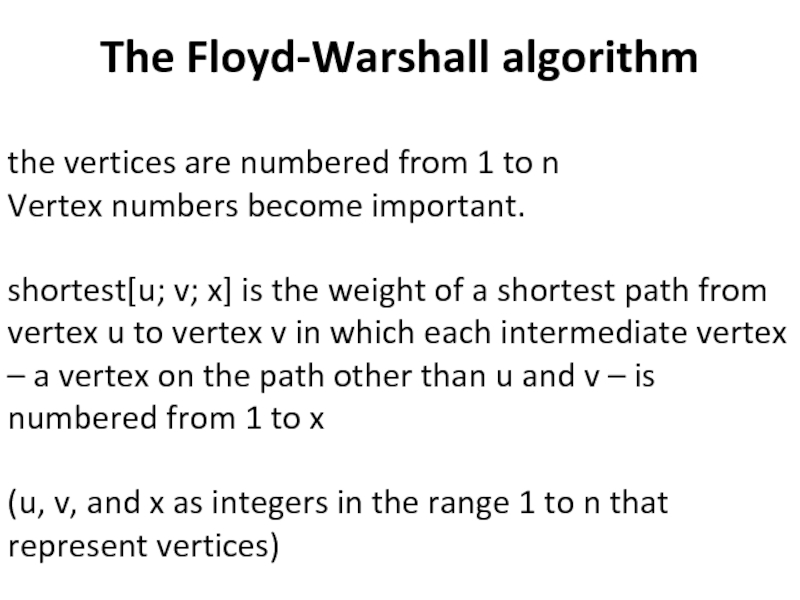
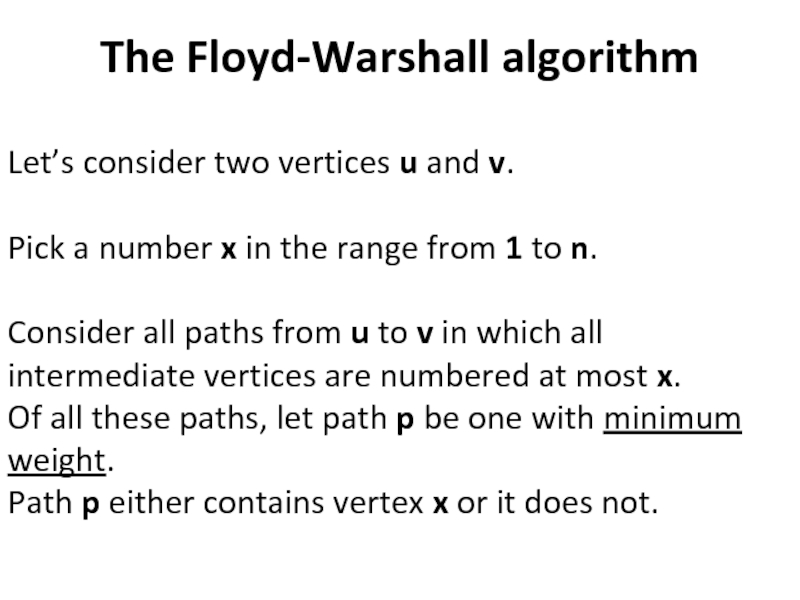
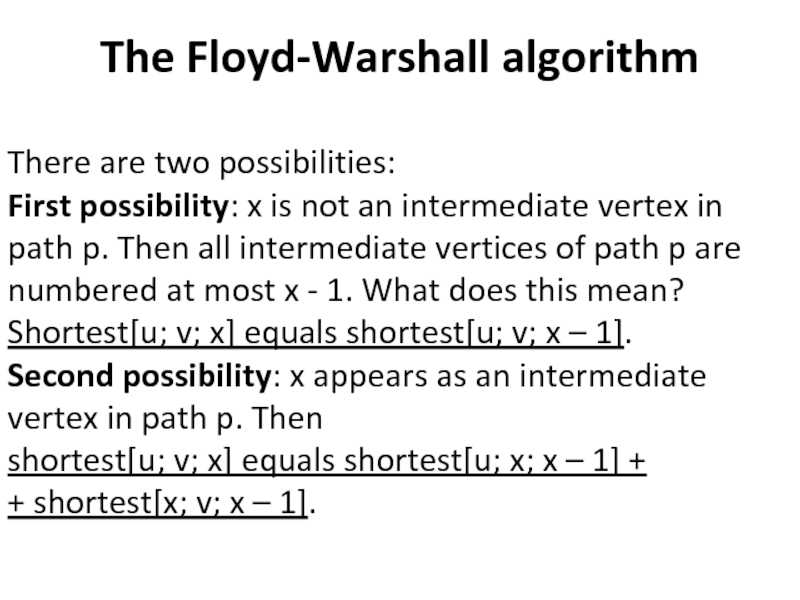
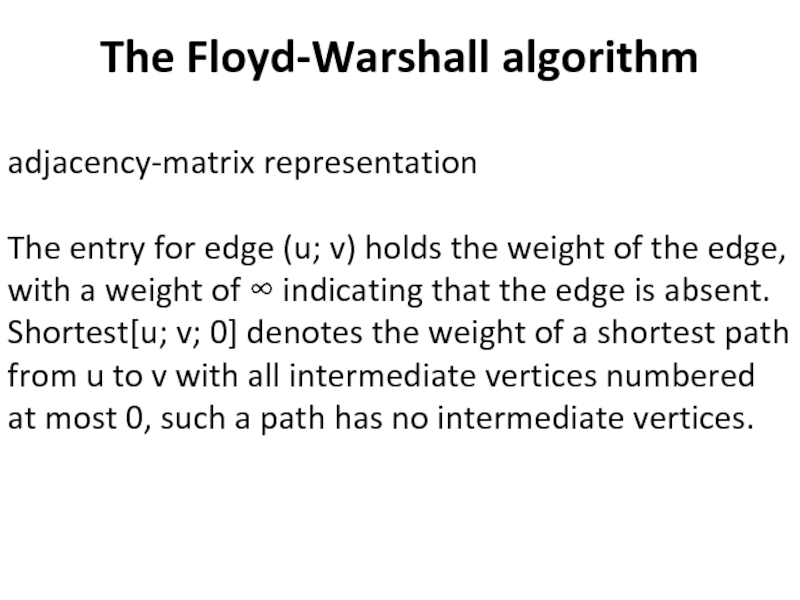
![The Floyd-Warshall algorithm computes shortest[u; v; x] values => x=1computes shortest[u; v; x] values =>](/img/tmb/4/346615/de507f0a7062fd7bb0547083655d09cf-800x.jpg)
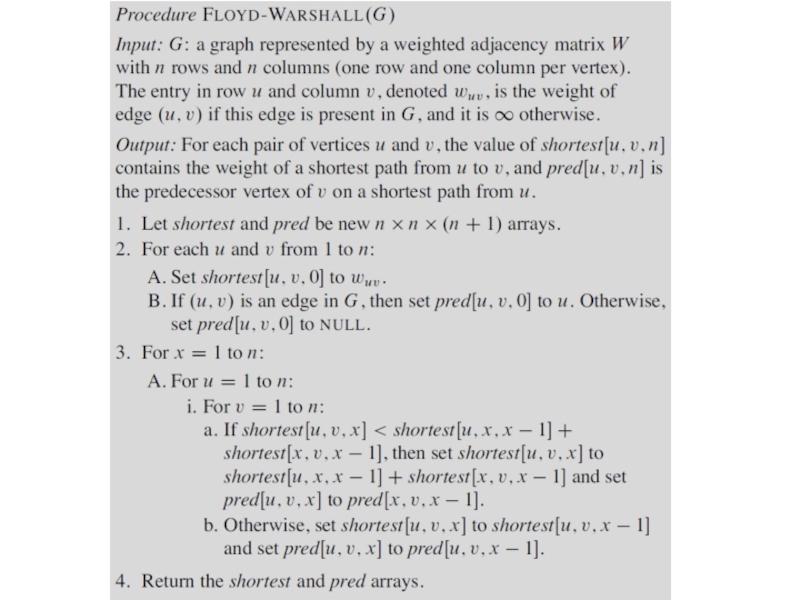
![The Floyd-Warshall algorithm exampleshortest[2; 4; 0] is 1, because we can get from vertex 2](/img/tmb/4/346615/a8124792774a42f81e773a171e1d0bc5-800x.jpg)
![The Floyd-Warshall algorithm pred[u; v; 0] values](/img/tmb/4/346615/d2eed6cfa8310ee465e0973308ffc7e8-800x.jpg)
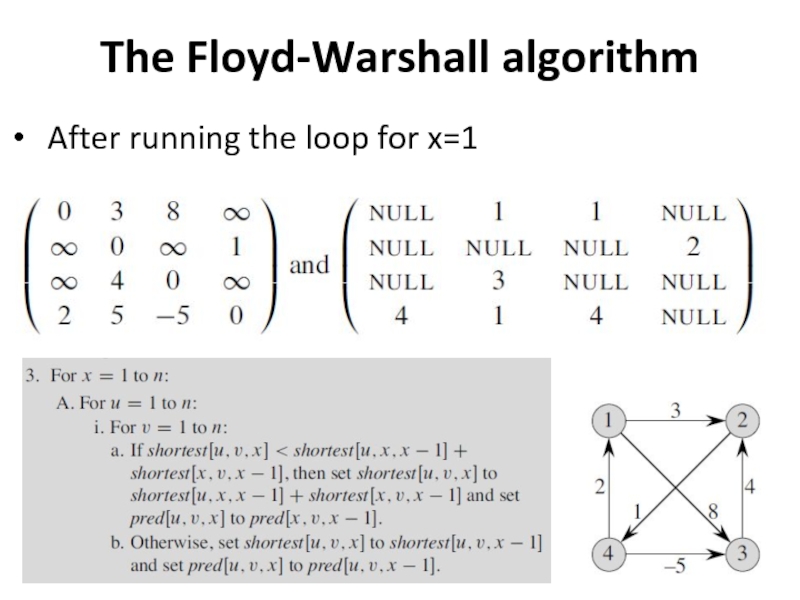
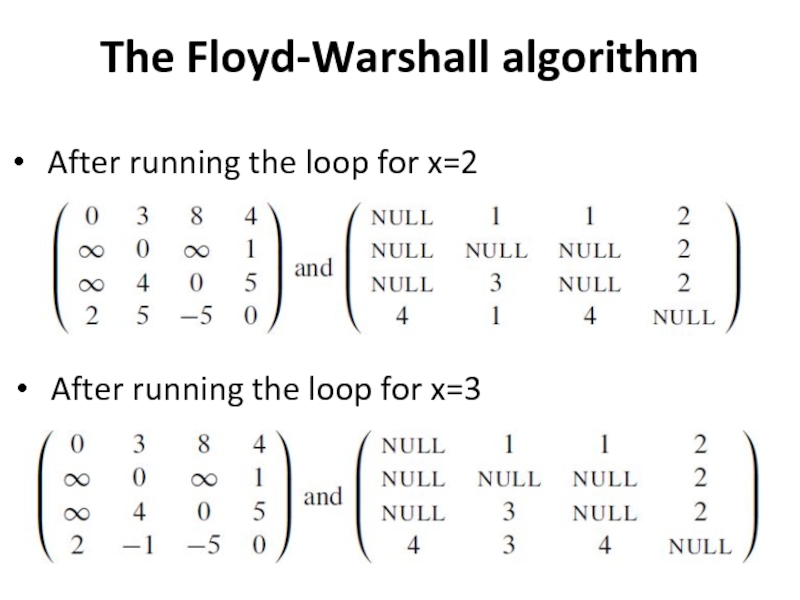
![The Floyd-Warshall algorithm shortest[u; v; 4] and pred[u; v; 4] values](/img/tmb/4/346615/6bb9d86ce039531e0bc78fc7e57517aa-800x.jpg)
